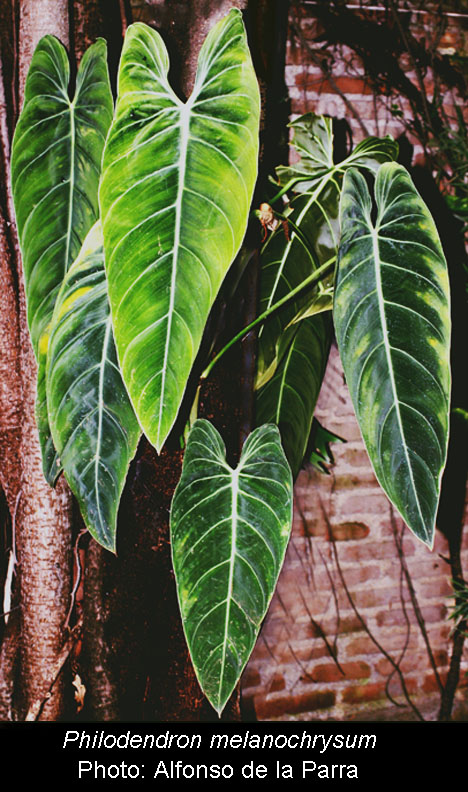![]()
Aroids and other genera in the Collection
Take the Tour Now?
Orchids
The
Exotic Rainforest
Plants in
the Exotic Rainforest Collection
Images on this website are copyright protected. Contact
us before attempting to reuse.
In depth information on how to grow Philodendron species, Click this Link
Within our collection we have many species of Philodendron. If you are seeking other photos, click this link
Philodendron melanochrysum Linden & André

Black Gold Philodendron, Velour Philodendron
 Philodendron species,
and especially hybrid forms, are
known to be highly variable and not every leaf of every specimen
will always appear the same. This link explains in greater
detail the scientific principle of natural variation and
morphogenesis.
Click
here.
Philodendron species,
and especially hybrid forms, are
known to be highly variable and not every leaf of every specimen
will always appear the same. This link explains in greater
detail the scientific principle of natural variation and
morphogenesis.
Click
here.
An epiphythe started from a cutting in 2005 our Philodendron melanochrysum has grabbed a tree and will eventually begin to climb up into the branches. Epiphytic species are those that climb a host tree in order to reach brighter light.
Many collectors acquire this plant as a small vine with very small leaves A strong climber, the species has leaves that are velutinous which look and feel like velvet. Like numerous other Philodendron sp. the leaves change shape and elongate as the plant climbs. Eventually the leaves will become approximately one meter (3 feet) long making it a spectacular addition to our artificial rainforest. The inset photo plant of a friend in Florida is about double that size and the second inset is of a mature plant. The petioles are terete (round). Collectors sometimes confuse this species with Philodendron gigas which has petioles that are "D" shaped when cut as a cross section.
P. melanochrysum is found naturally from Costa Rica to Columbia into Ecuador and down to Peru and is known to be variable. It produces an inflorescence but we have yet to see one bloom. Like all our Philodendron sp., we give it very well drained rich soil mixed with a lot of peat, mulch and humus along with high humidity and moderate light. This link offers a more complete explanation of natural variation within aroid species. Click here.
 Some websites confuse this plant and give it the name
Philodendron andreanum. That name, which commemorates the first
European collector of the plant Edouard Andre', was the first scientific
name given to the plant. Andre' found the plant in Columbia in 1886.
According to the text Aroids, Plants of the Arum Family,
"melanochrysum' means "black gold" and is used to describe the
tiny golden sparkles sometimes seen when the velvety blackish-green leaf
blades of adult plant are in sunlight. All of the most knowledgeable
sources
consider the correct name to be P. melanochrysum.
Some websites confuse this plant and give it the name
Philodendron andreanum. That name, which commemorates the first
European collector of the plant Edouard Andre', was the first scientific
name given to the plant. Andre' found the plant in Columbia in 1886.
According to the text Aroids, Plants of the Arum Family,
"melanochrysum' means "black gold" and is used to describe the
tiny golden sparkles sometimes seen when the velvety blackish-green leaf
blades of adult plant are in sunlight. All of the most knowledgeable
sources
consider the correct name to be P. melanochrysum.
Looking for a specimen? Contact
![]()
Want to learn more about aroids
Join the International Aroid Society: http://www.exoticrainforest.com/Join%20IAS.html